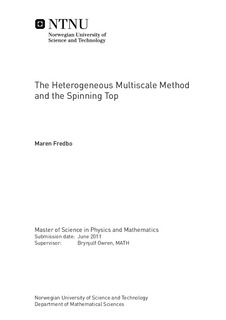The Heterogeneous Multiscale Method and the Spinning Top
Master thesis
Permanent lenke
http://hdl.handle.net/11250/258933Utgivelsesdato
2011Metadata
Vis full innførselSamlinger
Sammendrag
The heterogeneous multiscale method (HMM) was proposed by E and Engquist and is considered to be an efficient method for problems with multiple time scales. We give a short introduction to the HMM for multiscale problems in general, before we restrict our work to HMM schemes developed for stiff ODEs, based on results found by Engquist et al. HMM provides an efficient and systematic way to move between the macroscopic and microscopic model in a problem having multiscale physics. By taking advantage of scale separation in multiscale problems, the HMM approximates the macroscopic variables of the solution without fully resolving the microscopic solution. This introduces computational savings as the total number of evaluations needed for convergence are significantly reduced.We test the features of the HMM on the spinning top. The governing equations of the top produces a highly oscillatory solution as the top spins fast. Despite this fast oscillating nature, we would intuitively expect some slow behavior of the top, for instance the inclination from the vertical axis or the circulation of the top around the vertical axis. We find a set of slow variables of the spinning top, and show that the HMM provides an accurate solution of the macroscopic variables of the top, with a significant gain in computational cost compared to standard solvers.We also study the spinning top subjected to a vibrational external force and find a set of slow variables, which can be approximated accurately with HMM. Finally, we find an averaged equation to the spinning top subjected to a vertical vibrating force. This analysis is based on the Modulated Fourier expansion.The work of this thesis is an extension of my semester project, and we emphasize that the theory part of this thesis is partially from this work.
